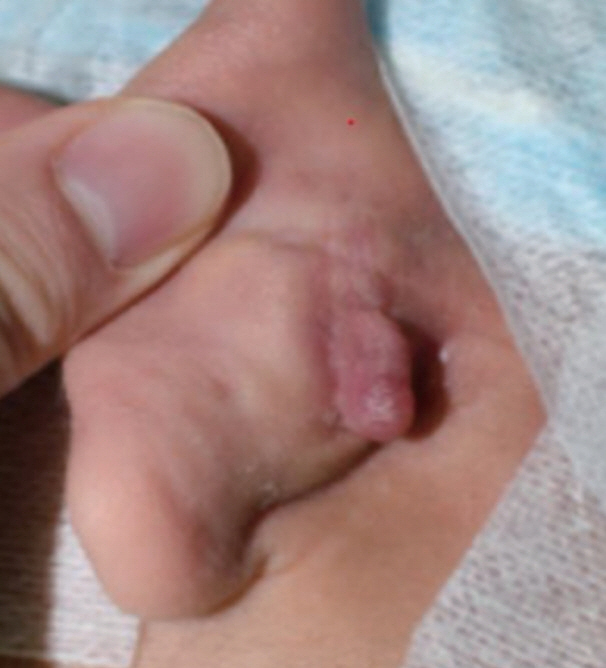J Rhinol.
2021 Jul;28(2):116-119. 10.18787/jr.2021.00350.
A Case of Auricular Keloid Resulting from Conchal Cartilage Graft in Asian Rhinoplasty
- Affiliations
-
- 1Department of Otorhinolaryngology, Nowon Eulji Medical Center, Eulji University School of Medicine, Seoul, Korea
- KMID: 2518678
- DOI: http://doi.org/10.18787/jr.2021.00350
Abstract
- When planning rhinoplasty, there are several options of grafts for augmentation, especially in relatively short and small Asian noses. Among such grafts, conchal cartilage is one of the most commonly used materials due to its histological similarity to nasal alar cartilage. Keloids and hypertrophic scars are fibroproliferative disorders that can occur after deep cutaneous injury. Since patients who wish to undergo rhinoplasty tend to have a lot of interest in cosmetic appearance, keloid formation can be serious complication to them. This case report presents an 18-year-old man who experienced keloid formation following conchal cartilage graft at 6 months after rhinoplasty. The authors introduce the case and review the considerations in prevention and treatment strategies for keloid scars after conchal cartilage harvest in Asian rhinoplasty.
Figure
Reference
-
References
1. Nicholas RS, Falvey H, Lemonas P, Damodaran G, Ghannem A, Selim F, et al. Patient-related keloid scar assessment and outcome measures. Plastic and Reconstructive Surgery. 2012; 129(3):648–56.2. Lee HJ, Jang YJ. Recent understandings of biology, prophylaxis and treatment strategies for hypertrophic scars and keloids. International Journal of Molecular Sciences. 2018; 19(3):711.3. Park TH, Seo SW, Kim JK, Chang CH. Outcomes of surgical excision with pressure therapy using magnets and identification of risk factors for recurrent keloids. Plastic and Reconstructive Surgery. 2011; 128(2):431–9.4. Jang YJ, Kim SH. Tip Grafting for the Asian Nose. Facial Plastic Surgery Clinics of North America. 2018; 26(3):343–56.5. Lan MY, Park JP, Jang YJ. Donor site morbidities resulting from conchal cartilage harvesting in rhinoplasty. The Journal of Laryngology and Otology. 2017; 131(6):529.6. Werner S, Krieg T, Smola H. Keratinocyte–fibroblast interactions in wound healing. Journal of Investigative Dermatology. 2007; 127(5):998–1008.7. Park TH, Park JH, Kim JK, Seo SW, Rah DK, Chang CH. Analysis of 15 cases of auricular keloids following conchal cartilage grafts in an asian population. Aesthetic Plastic Surgery. 2013; 37(1):102–5.8. Robles DT, Berg D. Abnormal wound healing: keloids. Clinics in Dermatology. 2007; 25(1):26–32.9. Leventhal D, Furr M, Reiter D. Treatment of keloids and hypertrophic scars: a meta-analysis and review of the literature. Archives of Facial Plastic Surgery. 2006; 8(6):362–8.10. Kim JH, Jang YJ. Use of diced conchal cartilage with perichondrial attachment in rhinoplasty. Plastic and Reconstructive Surgery. 2015; 135(6):1545–53.11. Darzi MA, Chowdri NA, Kaul SK, Khan M. Evaluation of various methods of treating keloids and hypertrophic scars: a 10-year follow-up study. British Journal of Plastic Surgery. 1992; 45(5):374–9.12. Kovalic JJ, Perez CA. Radiation therapy following keloidectomy: a 20-year experience. Int J Radiat Oncol Biol Phys. 1989; 17(1):77–80.13. Al-Attar A, Mess S, Thomassen JM, Kauffman CL, Davison SP. Keloid pathogenesis and treatment. Plastic and Reconstructive Surgery. 2006; 117(1):286–300.
- Full Text Links
- Actions
-
Cited
- CITED
-
- Close
- Share
- Similar articles
-
- Two Cases of Tragal Cartilage Graft in Rhinoplasty
- Simple Correction of Alar Retraction by Conchal Cartilage Extension Grafts
- Aesthetic Correction Using an Auricular Conchal Cartilage Graft and LASER for Nostril and Vestibular Stenosis
- Corrective Rhinoplasty with Combined Use of Autogenous Auricular Cartilage and Porcine Dermal Collagen in Cleft Lip Nose Deformity
- Design of a combined cartilage graft crusher, morselizer and holder for use in rhinoplasty



